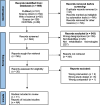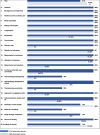Economic analysis of digital motor rehabilitation technologies: a systematic review
- PMID: 39014103
- PMCID: PMC11253330
- DOI: 10.1186/s13561-024-00523-5
Economic analysis of digital motor rehabilitation technologies: a systematic review
Abstract
Rehabilitation technologies offer promising opportunities for interventions for patients with motor disabilities. However, their use in routine care remains limited due to their high cost and persistent doubts about their cost-effectiveness. Providing solid evidence of the economic efficiency of rehabilitation technologies would help dispel these doubts in order to better take advantage of these technologies. In this context, this systematic review aimed to examine the cost-effectiveness of rehabilitation interventions based on the use of digital technologies. In total, 660 articles published between 2011 and 2021 were identified, of which eleven studies met all the inclusion criteria. Of these eleven studies, seven proved to be cost-effective, while four were not. Four studies used cost-utility analyses (CUAs) and seven used cost-minimization analyses (CMAs). The majority (ten studies) focused on the rehabilitation of the upper and/or lower limbs after a stroke, while only one study examined the rehabilitation of the lower limbs after knee arthroplasty. Regarding the evaluated devices, seven studies analyzed the cost-effectiveness of robotic rehabilitation and four analyzed rehabilitation with virtual reality.The assessment of the quality of the included studies using the CHEERS (Consolidated Health Economic Evaluation Reporting Standards) suggested that the quality was related to the economic analysis method: all studies that adopted a cost-utility analysis obtained a high quality score (above 80%), while the quality scores of the cost-minimization analyses were average, with the highest score obtained by a CMA being 72%. The average quality score of all the articles was 75%, ranging between 52 and 100. Of the four studies with a considering score, two concluded that there was equivalence between the intervention and conventional care in terms of cost-effectiveness, one concluded that the intervention dominated, while the last one concluded that usual care dominated. This suggests that even considering the quality of the included studies, rehabilitation interventions based on digital technologies remain cost-effective, they improved health outcomes and quality of life for patients with motor disorders while also allowing cost savings.
Keywords: Cost-effectiveness analysis; Disability; QALY; Rehabilitation technologies; Systematic review.
© 2024. The Author(s).
Conflict of interest statement
The authors declare no competing interests.
Figures




Similar articles
-
Economic Cost of Rehabilitation with Robotic and Virtual Reality Systems in People with Neurological Disorders: A Systematic Review.J Clin Med. 2024 Mar 7;13(6):1531. doi: 10.3390/jcm13061531. J Clin Med. 2024. PMID: 38541755 Free PMC article. Review.
-
Behavioural modification interventions for medically unexplained symptoms in primary care: systematic reviews and economic evaluation.Health Technol Assess. 2020 Sep;24(46):1-490. doi: 10.3310/hta24460. Health Technol Assess. 2020. PMID: 32975190 Free PMC article.
-
The cost-effectiveness of oral health interventions: A systematic review of cost-utility analyses.Community Dent Oral Epidemiol. 2018 Apr;46(2):118-124. doi: 10.1111/cdoe.12336. Epub 2017 Sep 19. Community Dent Oral Epidemiol. 2018. PMID: 28925508
-
The economic cost of robotic rehabilitation for adult stroke patients: a systematic review.JBI Database System Rev Implement Rep. 2019 Apr;17(4):520-547. doi: 10.11124/JBISRIR-2017-003896. JBI Database System Rev Implement Rep. 2019. PMID: 30973526
-
The Cost-Effectiveness of Digital Health Interventions on the Management of Cardiovascular Diseases: Systematic Review.J Med Internet Res. 2019 Jun 17;21(6):e13166. doi: 10.2196/13166. J Med Internet Res. 2019. PMID: 31210136 Free PMC article.
References
-
- Adie K, Schofield C, Berrow M, Wingham J, Humfryes J, Pritchard C, James M, Allison R. Does the use of Nintendo Wii SportsTM improve arm function? Trial of WiiTM in Stroke: a randomized controlled trial and economics analysis. Clin Rehabil. 2017;31:173–185. doi: 10.1177/0269215516637893. - DOI - PubMed
-
- Brusco N, Voogt A, Nott M, Callaway L, Mansoubi M, Layton N. Meeting Unmet Needs for Stroke Rehabilitation in Rural Public Health: Explorative Economic Evaluation of Upper Limb Robotics-Based Technologies through a Capabilities Lens. Societies. 2022;12:143. doi: 10.3390/soc12050143. - DOI
-
- Bustamante Valles K, Montes S, de Madrigal M, Burciaga A, Martínez ME, Johnson MJ. Technology-assisted stroke rehabilitation in Mexico: a pilot randomized trial comparing traditional therapy to circuit training in a Robot/technology-assisted therapy gym. J NeuroEng Rehabil. 2016;13:83. doi: 10.1186/s12984-016-0190-1. - DOI - PMC - PubMed
-
- CADTH, 2020. Guidelines for the Economic Evaluation of Health Technologies: Canada | CADTH [WWW Document]. URL https://www.cadth.ca/guidelines-economic-evaluation-health-technologies-.... Accessed 31 Jan 2024.
Publication types
LinkOut - more resources
Full Text Sources
Miscellaneous

